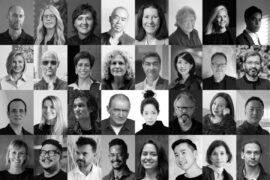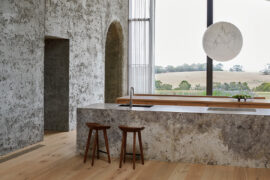The architect is praised for producing a body of work that opens new horizons while resonating with place and memory.
February 29th, 2012
Chinese architect Wang Shu has been announced as the winner of this year’s prestigious Pritzker Architecture Prize – often described as the ‘Nobel prize of architecture’.

Ceramic House, 2003 – 2006, Jinhua, China
Thomas J. Pritzker, chairman of The Hyatt Foundation, which sponsors the prize, explains the significance of this year’s winner.
“The fact that an architect from China has been selected by the jury represents a significant step in acknowledging the role that China will play in the development of architectural ideals. In addition, over the coming decades China’s success at urbanisation will be important to China and to the world… China’s unprecedented opportunities for urban planning and design will want to be in harmony with both its long and unique traditions of the past and with its future needs for sustainable development.”

Xiangshan Campus, China Academy of Art, Phase I, 2002 – 2004, Hangzhou, China
Pritzker Prize jury chairman The Lord Palumbo says that Wang’s work is able to transcend the current debate “as to whether architecture should be anchored in tradition or should look only toward the future”. Wang’s work, he says, is “timeless, deeply rooted in its context and yet universal”.

Xiangshan Campus, China Academy of Art, Phase I
The 48-year-old architect runs Hangzhou-based “Amateur Architecture Studio” with his wife, Lu Wenyu, where traditional understanding, experimental building tactics, and intensive research form the basis of their work.

Ningbo History Museum, 2003 – 2008, Ningbo, China
His completed projects include the Library of Wenzheng College at Suzhou University, Ningbo Contemporary Art Museum, Ningbo History Museum, Xingshan Campus of the China Academy of Art, Vertical Courtyard Apartments, and the Ceramic House.

Ningbo History Museum
International accolades include the French Gold Medal from the Academy of Architecture in 2011, and the German Schelling Architecture Prize in 2010 – a joint award with his wife.

Ningbo Tengtou Pavilion (2010), Shanghai Expo, China
Wang Shu has expressed considerable surprise at his win, saying that he is greatly honoured. “I suddenly realised that I’ve done many things over the last decade. It proves that earnest hard work and persistence lead to positive outcomes.”
Past Pritzker Prize laureates include Frank Gehry (US), Zaha Hadid (UK), Rem Koolhaas (the Netherlands), Renzo Piano (Italy), Jean Nouvel (France), SANAA (Japan) and, just last year, Eduardo Souto de Moura (Portugal).
The Pritzker Architecture Prize
pritzkerprize.com
INDESIGN is on instagram
Follow @indesignlive
A searchable and comprehensive guide for specifying leading products and their suppliers
Keep up to date with the latest and greatest from our industry BFF's!

For Aidan Mawhinney, the secret ingredient to Living Edge’s success “comes down to people, product and place.” As the brand celebrates a significant 25-year milestone, it’s that commitment to authentic, sustainable design – and the people behind it all – that continues to anchor its legacy.

Gaggenau’s understated appliance fuses a carefully calibrated aesthetic of deliberate subtraction with an intuitive dynamism of culinary fluidity, unveiling a delightfully unrestricted spectrum of high-performing creativity.
Design Build 2010 will showcase local and international building products, services and technologies in Australia.
thedesignvlog.com gets lost in designer translation within the streets of Tokyo, embracing the interiors of so many of their incredible fashion retailers.
Dorf’s first and favourite mixer now comes in a wider range with the release of a basin mixer, and bath/shower mixer with or without diverter. Beautifully constructed from solid brass, Flickmixer is built to last. And with a Ceramic Disc cartridge assuring water saving without compromising performance, Flickmixer is an obvious choice. Sleek lines and […]
The internet never sleeps! Here's the stuff you might have missed

With the 2025 INDE.Awards now over, it’s time to take a breath before it all begins again in early December. However, integral to the awards this year and every year is the jury – and what an amazing group came together in 2025.

The INDE.Awards 2025 has named House on a Hill by Leeton Pointon Architects and Allison Pye Interiors as the winner of The Interior Space category, presented by Tongue & Groove. This multigenerational country home on Bunurong Country redefines residential architecture and design with its poetic balance of form, function, and sanctuary.